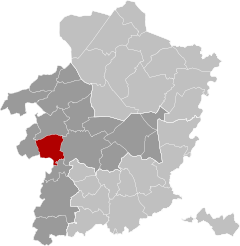Herk-de-Stad
Herck-la-Ville (French) | |
|---|---|
City and municipality | |
 | |
| Coordinates: 50°56′N 05°10′E / 50.933°N 5.167°E | |
| Country | |
| Community | Flemish Community |
| Region | Flemish Region |
| Province | Limburg |
| Arrondissement | Hasselt |
| Government | |
| • Mayor | Bert Moyaers (Vooruit) |
| • Governing party/ies | Vooruit, Open VLD, CD&V |
| Area | |
• Total | 43.03 km2 (16.61 sq mi) |
| Population (2018-01-01)[1] | |
• Total | 12,661 |
| • Density | 290/km2 (760/sq mi) |
| Postal codes | 3540 |
| NIS code | 71024 |
| Area codes | 013, 011 |
| Website | www.herk-de-stad.be |
Herk-de-Stad (Dutch pronunciation: [ˈɦɛr(ə)ɡ də ˈstɑt] ; French: Herck-la-Ville, French pronunciation: [ɛʁk la vil]) is a city and municipality located in the Belgian province of Limburg. On 1 January 2018, Herk-de-Stad had a total population of 12,661. The total area is 42.83 km2 which gives a population density of 296 inhabitants per km2.
Besides the village of Herk-de-Stad itself, the municipality contains the communities of Berbroek, Schulen and Donk. Donk contains two country houses, both of the eighteenth-century, Kasteel Hamont and Kasteel Landwijk, which stands on the site of a castle established in the 12th century.

- ^ "Wettelijke Bevolking per gemeente op 1 januari 2018". Statbel. Retrieved 9 March 2019.




